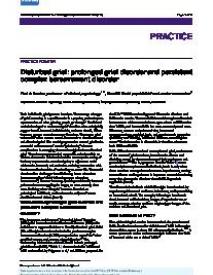Disturbed grief : prolonged grief disorder and persistent complex bereavement disorder
What you need to know
-
When confronted with the death of a loved one, most people experience transient rather than persistent distress, and do not develop a mental health condition.
-
Bereavement, specifically the sudden, unexpected death of a loved one is associated with an elevated risk for multiple psychiatric disorders.
-
Consider prolonged grief disorder (PGD) in people with ongoing separation distress beyond the first six to 12 months of bereavement.
-
PGD occurs in approximately 10% of bereaved individuals, with an increased risk following the death of a partner or child and loss to unnatural or violent circumstances, and among people vulnerable to mental health conditions.
-
Psychological treatments addressing the pain and consequences associated with the irreversibility of the separation can be effective.
-
Emerging evidence provides limited support for pharmacological interventions.
Each individual’s grief process is unique. The concept of stages of grief occurring in a specific order is a popular, yet inadequate representation of what grieving people go through.1 Traditional models developed to understand grief therefore often unhelpfully suggest that all bereaved individual do, and even should, follow the same process towards recovery from loss. The newer grief task model2 offers a more neutral framework to describe normal and disturbed grief.
The model proposes that normal grief is the successful achievement of certain “grief tasks,” whereas complications in managing these tasks might indicate disturbed grief. There is no recommended or specific order in which to achieve these tasks. Grief tasks include: to accept the reality of the loss; to process the associated pain; to adjust to a world without the deceased; and to find an enduring connection with the deceased in the midst of embarking on a new life.
The model also describes challenges faced following losses other than bereavement (Box ‘Grief following events other than bereavement’). Doctors from any specialty can identify bereaved patients who are struggling for longer, or more severely than most. Defining when this grief becomes disturbed or pathological is difficult, and has been the subject of recent classification and debate (box 1).
Geachte bezoeker,
De informatie die u nu opvraagt, kan door psychotraumanet niet aan u worden getoond. Dit kan verschillende redenen hebben,
waarvan (bescherming van het) auteursrecht de meeste voorkomende is. Wanneer het mogelijk is om u door te verwijzen naar de bron
van deze informatie, dan ziet u hier onder een link naar die plek.
Als er geen link staat, kunt u contact opnemen met de bibliotheek,
die u verder op weg kan helpen.
Met vriendelijke groet,
Het psychotraumanet-team.
In: British medical journal, ISSN 0959-535X ; eISSN 0959-8138 | [357] | May | j2016
https://doi.org/10.1136/bmj.j2016
May 18


